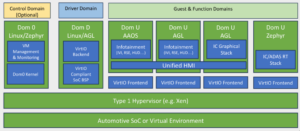
![]() Ryan Daws is a senior editor at TechForge Media with over a decade of experience in crafting compelling narratives and making complex topics accessible. His articles and interviews with industry leaders have earned him recognition as a key influencer by organisations like Onalytica. Under his leadership, publications have been praised by analyst firms such as Forrester for their excellence and performance. Connect with him on X (@gadget_ry), Bluesky (@gadgetry.bsky.social), and/or Mastodon (@gadgetry@techhub.social)
Ryan Daws is a senior editor at TechForge Media with over a decade of experience in crafting compelling narratives and making complex topics accessible. His articles and interviews with industry leaders have earned him recognition as a key influencer by organisations like Onalytica. Under his leadership, publications have been praised by analyst firms such as Forrester for their excellence and performance. Connect with him on X (@gadget_ry), Bluesky (@gadgetry.bsky.social), and/or Mastodon (@gadgetry@techhub.social)
A tipster gives us a peek under the hood of the Samsung XR headset, the company’s answer to the Apple Vision Pro.
After several teaser appearances – most notably at Google I/O where the tech giant confirmed Samsung would launch “Project Moohan” later this year – a fresh leak has shed light on what’s powering the Korean manufacturer’s XR headset.
Ever-reliable tipster Abhishek Yadav has done what tipsters do best, sharing a Geekbench screenshot on X that gives us a glimpse into Samsung’s hardware choices.
Samsung’s XR Project Moohan SM-I610 spotted on Geekbench with Adreno 740 GPU.
Specifications
🔳 6-cores at 2.36GHz
🎮 Adreno 740 GPU (The Adreno 740 GPU is integrated with Qualcomm’s Snapdragon 8 Gen 2, but here it appears to be part of a different chipset/SoC.)
🍭 Android 14
-… pic.twitter.com/yfnxH45zRm— Abhishek Yadav (@yabhishekhd) May 27, 2025
The benchmark clearly labels the device with model number “SM-I610” and confirms what many of us suspected—it’s running Qualcomm’s beefy Snapdragon XR2 Plus Gen 2 processor.
Qualcomm unveiled this silicon last year, purposely crafting it to handle the unique demands of extended reality experiences with Adreno GPUs that excel at rendering complex 3D environments without bringing frame rates crashing down—something that would quickly turn an immersive experience into a nauseating one.
What’s under the bonnet of the Samsung XR headset?
The processor appears to be sporting six CPU cores humming along at 2.36GHz, paired with an Adreno 740 GPU. If that graphics unit sounds familiar, it’s because similar versions power some of today’s top-shelf Android mobiles.
Performance-wise, the benchmark shows single and multi-core scores of 990 and 2,453 respectively. While numbers alone don’t tell the whole story, these results suggest Samsung isn’t messing about when it comes to raw processing power.
Perhaps most telling is the 16GB of RAM that accompanies the chipset. That’s a decent amount of memory for a headset and hints at Samsung’s ambitions for multitasking and complex applications. The device appears to be running Android 14, specifically tailored for XR environments—again, no surprises there, given Google’s involvement in the project.
Seeing is believing
While the benchmark doesn’t spill the beans on display tech, the rumour mill suggests Samsung has opted for Sony’s 4K micro-OLED displays. If true, we’re looking at a visual experience with 3,552 × 3,840 resolution.
For context, that’s likely to deliver considerably sharper visuals than what you’d find in Meta’s Quest 3, though perhaps not quite matching the eye-watering clarity of Apple’s Vision Pro. The displays reportedly pump out 1,000 nits of brightness while drawing just 20% power — efficiency that could prove crucial for extending battery life, traditionally a weak point for XR headsets.
Colour reproduction appears strong too, with 96% coverage of the DCI-P3 gamut, while the 90fps refresh rate strikes a sensible balance between smoothness and performance.
One aspect that piques my interest is Samsung’s integration of Google’s Gemini AI capabilities. In a world where every tech product seems to be slapping AI onto the spec sheet, the partnership with Google could deliver meaningful benefits in a spatial computing context.
Imagine asking Gemini to analyse what you’re looking at through the headset’s cameras, or having it suggest contextual information without breaking your immersion. The possibilities are exciting if implemented thoughtfully.
Increasingly crowded market
Samsung isn’t exactly first to this particular party. Apple’s Vision Pro has already made waves with its impressive capabilities but unaffordable (for most of us) £3,499/$3,499 price tag, while Meta continues to dominate the more affordable end of the spectrum with its Quest lineup.
What makes Samsung’s entry fascinating is the company’s unique position. Unlike Apple, Samsung has years of experience working closely with Google on Android, potentially giving it a software edge over other Android-based contenders. And, unlike Meta, Samsung isn’t primarily dependent on advertising revenue.
The Google partnership hints at a focus on ecosystem integration that could make or break the headset’s appeal. After all, what good is fancy hardware if there’s nothing compelling to do with it?
As we edge closer to the promised “later this year” launch window, the burning questions shift from raw specifications to more practical concerns. How comfortable will it be during extended use? What’s the battery life like? And perhaps most crucially for mass adoption, what price point is Samsung targeting?
If Samsung can thread the needle between Meta’s accessibility and Apple’s premium experience – while leveraging its display manufacturing prowess – we could be looking at a genuine contender in the XR space.
For developers and tech enthusiasts alike, Samsung’s entry represents another vote of confidence in spatial computing as the next major computing platform. Whether it succeeds or stumbles will depend not just on these impressive specs, but on the ecosystem and experiences Samsung and Google can cultivate around the hardware.
(Image credit: Samsung)
See also: Google Home is finally getting smart with Gemini AI

Want to learn about the IoT from industry leaders? Check out IoT Tech Expo taking place in Amsterdam, California, and London. The comprehensive event is co-located with other leading events including Cyber Security & Cloud Expo, AI & Big Data Expo, Intelligent Automation Conference, Edge Computing Expo, and Digital Transformation Week.
Explore other upcoming enterprise technology events and webinars powered by TechForge here.




